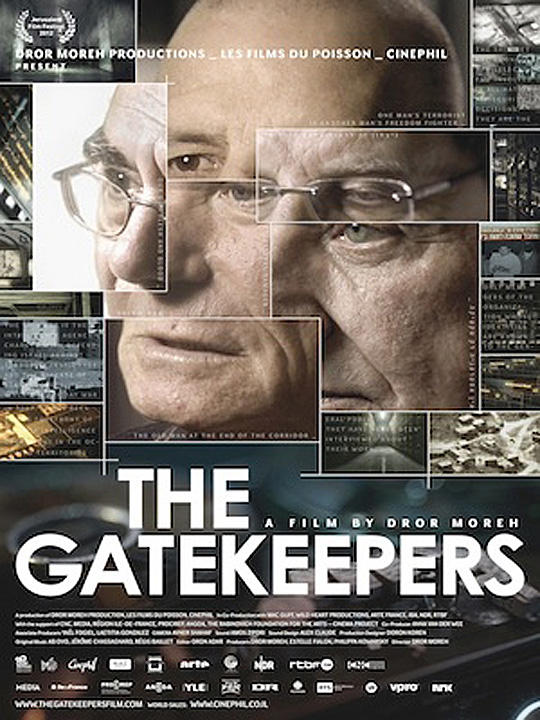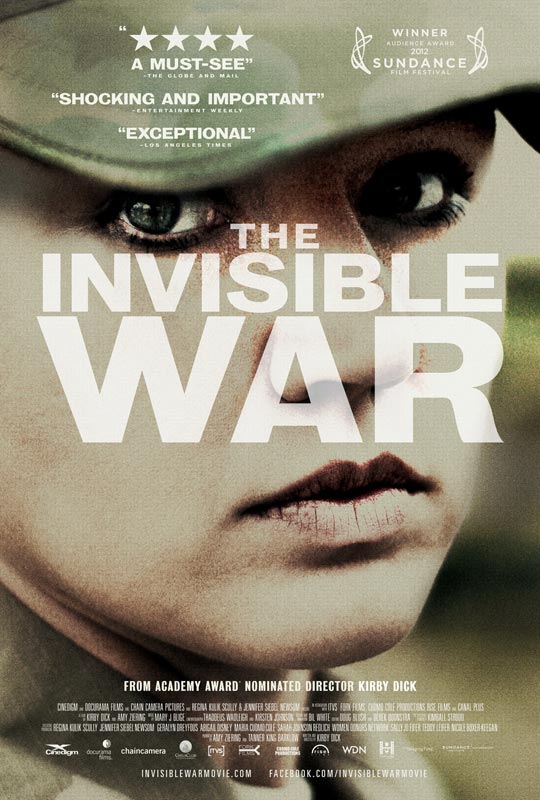Guest post written by Jo Custer.
The lifecycle of documentaries aspiring to global visibility begins each year at Sundance mid-January and ends in December when Oscar nomination voting begins. Of the five nominated this year, four premiered quietly at Robert Redford’s House of Docs, while The Gatekeepers — a series of interviews with former heads of Shin Bet, Israel’s NSA and CIA in one — slipped into the running even more quietly via Telluride, after its Jerusalem debut.
Film writers often tout the launching success of the year’s first Academy qualifying festival and can even present bias which may be attributable to the competition structure, as the Wall Street Journal did when it printed that Kirby Dick’s expose on the treatment of military rape victims, The Invisible War, would be one to watch but overlooked How to Survive a Plague, David France’s long, slow grip on the fight to normalize healthcare for AIDS victims. Both nominees were in the U.S. documentary competition. Only one of the WSJ‘s picks for Sundance-projected success came from the world cinema documentary competition, and it wasn’t Searching for Sugarman, Malik Bendjelloul’s bizarre tale of a Detroit singer/songwriter who recorded two flop albums and then quietly became a demi-god in apartheid-era South Africa. Nor was it 5 Broken Cameras, in which Guy Davidi chronicles Palestinian Emad Burnat’s inability to keep a camera operational in the suffocating presence of the Israeli Army.
Without conflating the already hard to separate issues of press-generated success vs. Oscar-generated success, this year’s most monetarily rewarding mark of honor has drawn five films. That’s five films from a pool that increases yearly at a hard-to-measure growth rate. When Sundance first created the House of Docs in 1999, theatrical releases of non-fiction films represented less than two percent of all releases, according to figures collected from Box Office Mojo. Since 2001 non-fiction theatrical releases have grown, sometimes doubling or tripling in a year until in 2011 documentaries comprised 18% of all films released.
Coinciding with the growing interesting in non-narrative film, there has been a noticeable uptick in women documentarians as well. Dozens can be found in lists of 2012 docs to watch that didn’t make the Oscar list, including Amy Berg (West of Memphis), Alison Klayman (Ai Weiwei: Never Sorry), Katie Dellamaggiore (Brooklyn Castle), Lauren Greenfield (The Queen of Versailles), Heidi Ewing and Rachel Grady (Detropia, Jesus Camp), Susan Froemke (ESCAPE FIRE: The Fight to Rescue American Health Care), and Kristi Jacobson and Lori Silverbush (Finding North). U.S. women represented fifty percent of documentarians at Sundance last year while international women documentarians were outnumbered eleven to four.
Disregarding for a moment whatever else the relationship between these numbers might suggest, two things continue to happen. First, despite the rise in the number of docs which garner theatrical releases, their box office revenues remain low, short-term. Second, the one body with the power to make a filmmaker’s career in the short term — the Academy — continues to play it safe in its selection of documentaries to bring into the limelight. What makes this year’s lineup incredibly hard to argue against isn’t the documentaries themselves, but rather what they represent: a carefully balanced melange of social justice issues, most of which effect women, but all of which were brought about by the storytelling devices of men.
 |
| The Invisible War |
The most salient of these to American audiences, Kirby Dick, took on the U.S. military in The Invisible War, in defense of thousands of rape victims across all branches who are silenced far more often than their offenders are brought to justice. Dick began his David vs. Goliath track record with This Film Is Not Yet Rated, taking on the MPAA with an honesty that everyone but the ratings body itself cared about. According to the action kicker just before the credits, Defense Secretary Leon Pannetta disallowed commanding officers to govern processing for rape victims two days after seeing the film, which notes that officers aren’t just getting away with rape but learning how to maneuver the justice system before returning to civilian life with no record of being a sex offender. Hard-hitting and hard to watch, the film seems to have done part of its job. Perhaps more importantly to the Academy, it is the token women’s film this year. Not all victims of military rape are female, of course, but this was the year of the War On Women. Apparently, Kirby Dick’s take on that will serve as our commemoration.
 |
| How to Survive a Plague |
Perhaps less salient — if only because memories are short — David France’s long-suffering piecing together of how gay men and lesbians banded together under a retired chemist and housewife to learn about AIDS and how to fight it rings truer to its subjects’ voices. Opening in “Year 6 of the Epidemic” in Greenwich Village, the epicenter of the plague, it tells the story the networks kept from the news each night of Reagan’s presidency. There were no drugs to treat the disease. People were being turned away. It was nearly one hundred percent fatal. People who were dying anyway laid down in the streets to protest and be arrested and went the opposite way of the closet eventually — away from the black market and into the realm of FDA tested, prescribable drugs. Archival footage from dozens of sources make this authentic look at what it means to be an activist layered but also fatiguing, as though France wants the viewer to feel the malaise of too many years of dying and not nearly enough justifying. Just as notable, the camera never gets too close to the women. It’s a men’s story, in the end.
 |
| Searching for Sugarman |
Another absorbing and visceral man’s story is Searching for Sugarman, which surprises and delights in its juxtaposition of two very different climes — Detroit in 1968 – 1971 and South Africa at the height of apartheid. The “Sugarman” of interest is none other than Rodriguez, whose career never really got out of the studio in North America. But his first album made its way to South Africa and got copied and redistributed and bought in such demand that he became, according to figures in the film, bigger than Elvis or The Rolling Stones. His music inspired a censorship sick society to rally behind music and a movement that eventually won. Filmmaker Malik Bendjelloul left Sweden to globe-trot and stumbled across the Rodriguez story while in South Africa. Considering how uplifting the storytelling is, he chose well.
 |
| 5 Broken Cameras |
In 5 Broken Cameras, Guy Davidi remains the silent silent director while Emad Burnat tells the story of his life in Palestine since the Israelis began encroaching actively upon his community and house and life. Showing footage from each of Emad’s cameras interstitially but linearly, it attempts to avoid the macrocosm argument of whose land it is by focusing on the microcosm but never quite makes it. The Israeli Army demonstrates its displeasure with Palestine time and time again, tearing up olive trees and soil for no other reason than its being there. Its most effective moment comes in a little seen glimpse of Islamic married life, in which Emad’s wife, beyond tired of her husband’s preoccupation with the distance the lens gives him, yells at him to turn off the camera while she performs domestic duties, but he does not. He can’t, not even when he is placed under house arrest. He films himself doing nothing because filming is what he does. Very heavy on the imagery of Emad’s son, it is another man’s story — set on the most unstable ground in the world, and still often seen as the center of it.
 |
| The Gatekeepers |
Almost as if to be fair to the uprooters of innocent olive trees, the Academy also nominated Dror Moreh’s The Gatekeepers, which I did not get a chance to see thanks to a limited release and a tight grip on screeners. It features interviews with six former heads (all men) of Shin Bet, the “unseen shield” of Israel — a far more authoritarian point of view than Emad’s.
It seems more than safe to say that the Academy may have been influenced politically to seek a balance in representing both sides of an ongoing conflict. But safety was ever the problem with this year’s documentary lineup: A “women’s issue” delivered by a well-respected man during the War on Women; a pleaser for the LGBTIQ community who showed up a little less strong in this year’s Presidential election, but still showed; a token non-issue entertainment piece that also happens to shine in its unusualness; and two pieces from the Middle East. Under Academy auspices, docs play like little more than complementary copy.
In case you were wondering, Sugarman has my bet for best doc of the year. As does women’s continuation to make social justice documentaries for almost no monetary return, but rather making names for themselves that will last. Hopefully it will rub off in the darker places, too.
———-
Jo Custer is a New Orleans writer/director/producer, theatre director, blogger and sometimes a journo. She has just finished auditions for her next short film, Sonuvabitch, gearing up to shoot this May and will also be directing The Four of Us for the stage this spring. You can follow her sojourns as a filmmaker/cab driver here: http://jocuster.wordpress.com/

1 thought on “2013 Oscar Week: Academy Documentaries: People’s Stories, Men’s Voices”
Comments are closed.